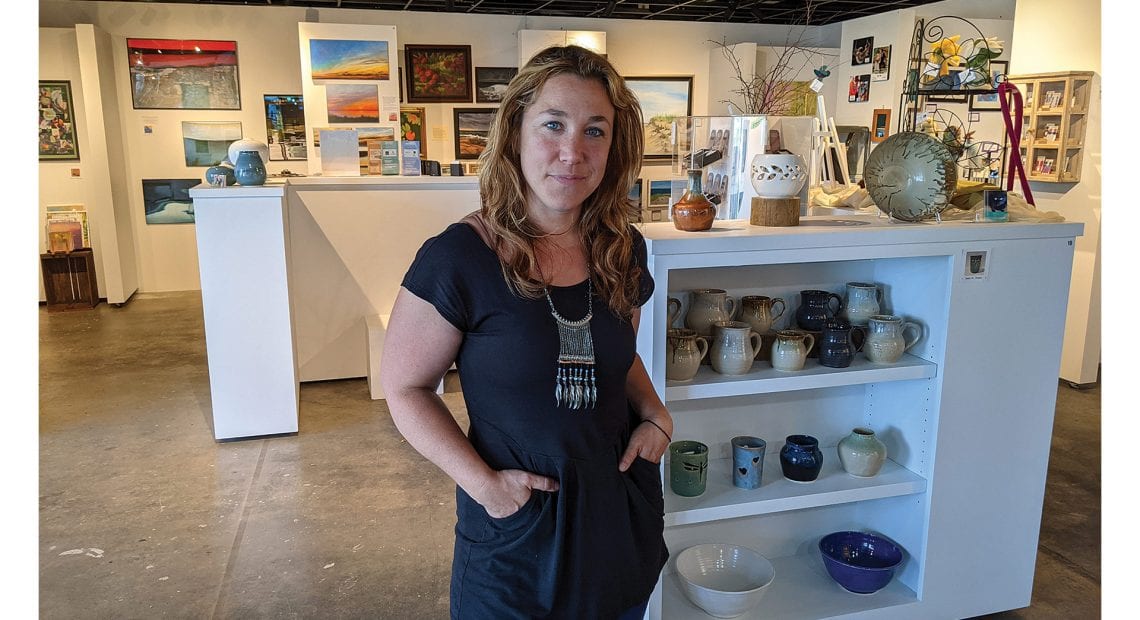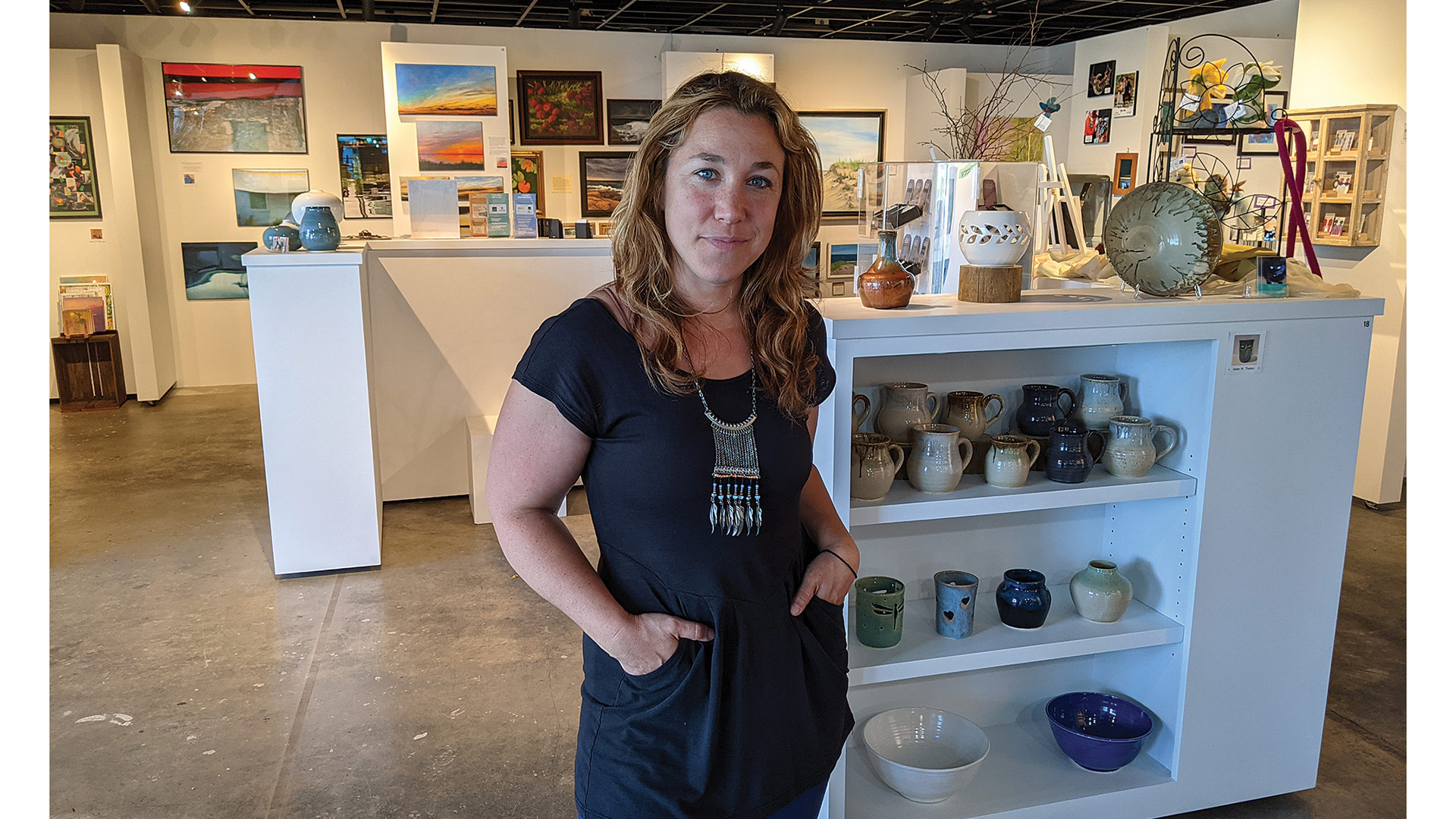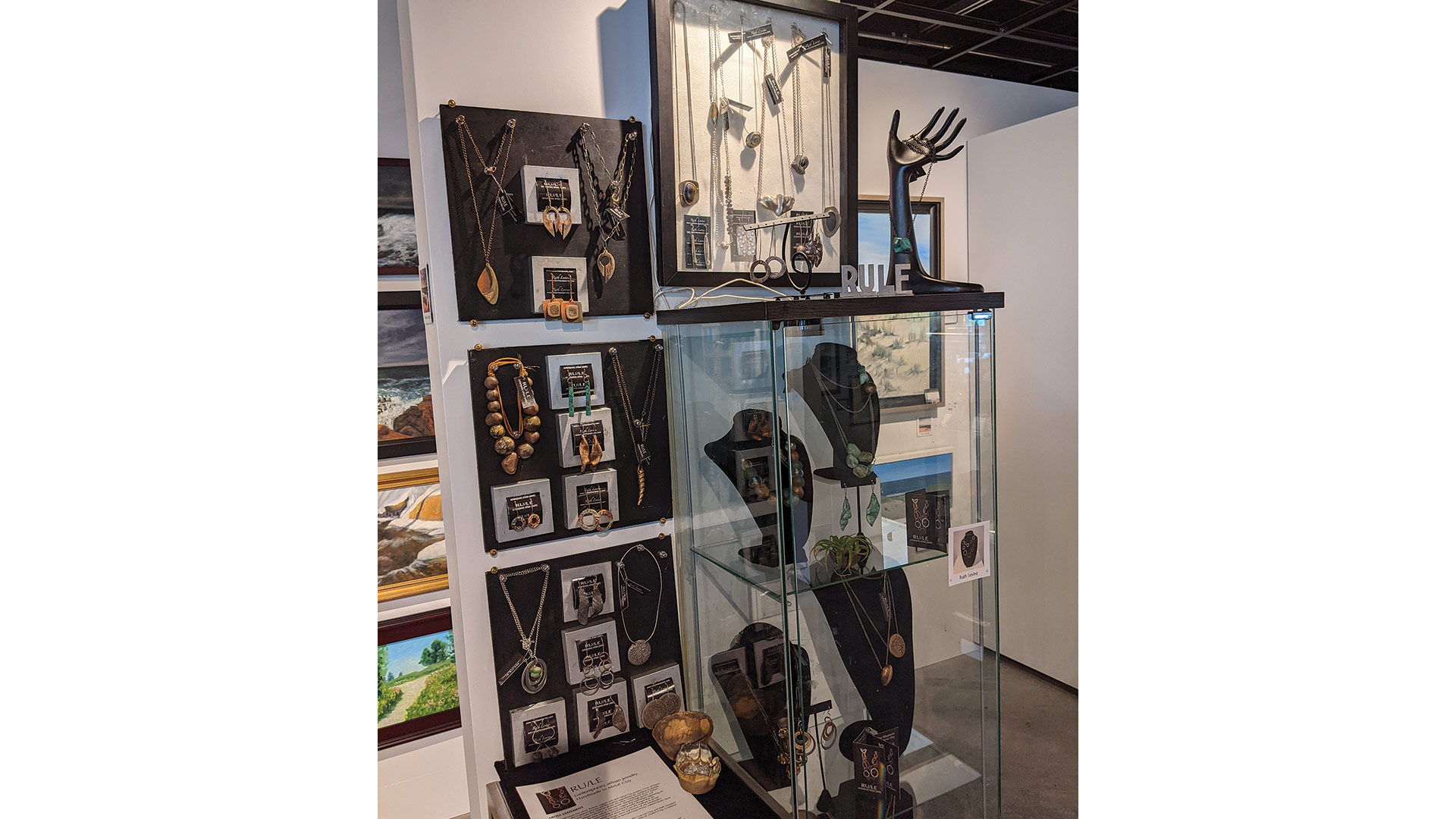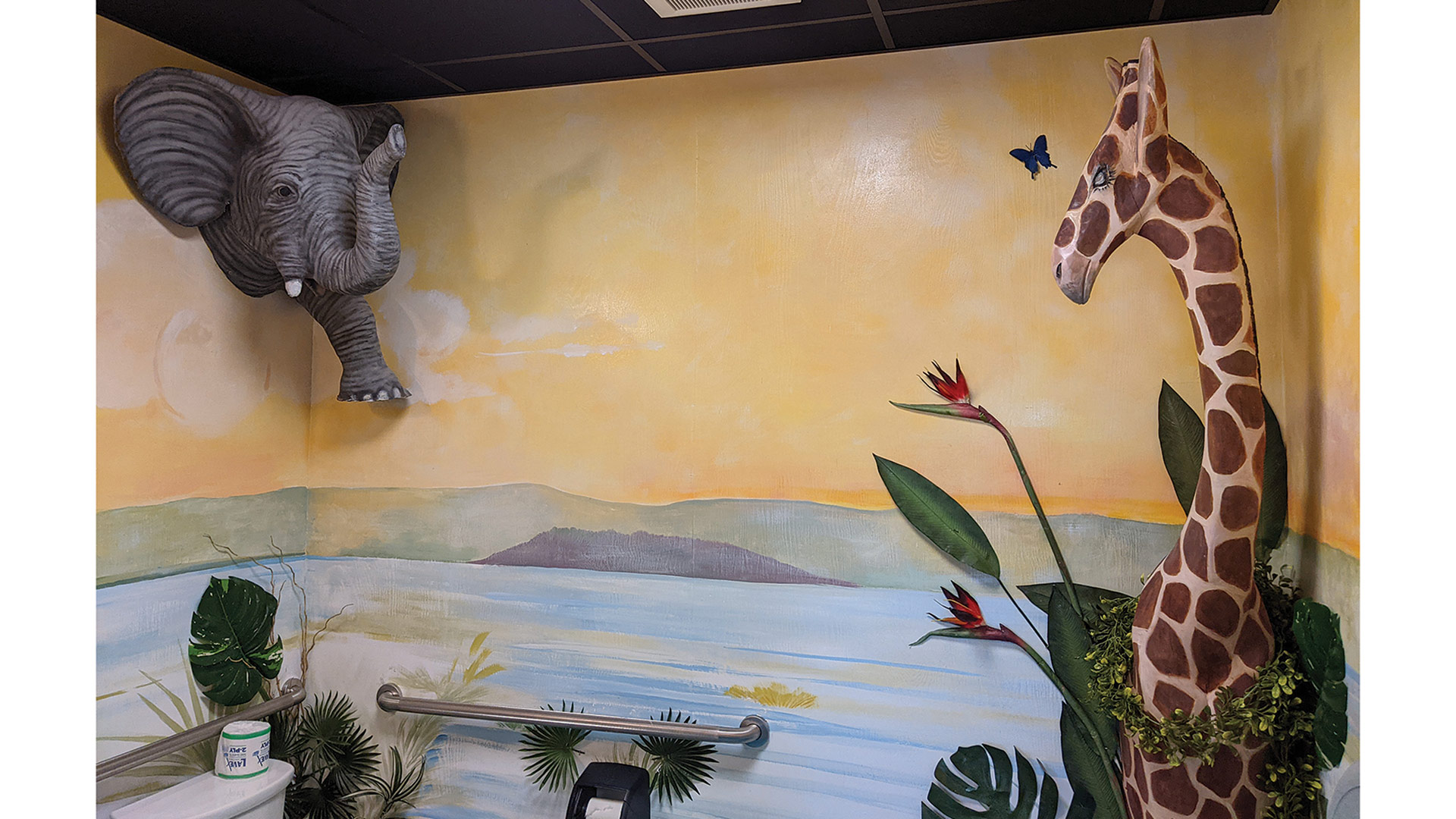
Hannah’s Local Art Gallery Brings Creative Energy to the Mill District
Crafting Connections

Hannah Rechtschaffen, director of placemaking for the Mill District and manager of Hannah’s Local Art Gallery.
When Hannah Rechtschaffen set about to open an art gallery in Amherst’s Mill District, she didn’t envision a static space; instead, her goal was to develop a vibrant, eclectic, multi-media gallery that not only focused on local artists, but forged connections between them and the public through workshops, classes, events, and even the everyday conversations that bring to life the stories and history behind each artist and each piece. A couple weeks after the gallery’s opening, she’s optimistic those creative collisions are already happening.
Anika Lopes’ roots in Amherst go back six generations, so the town is special to her. But as a milliner — an artist who designs and creates hats — she has made her name in galleries and boutiques in much larger cities, especially New York.
Now, as the highlighted artist for the recent grand opening of Hannah’s Local Art Gallery in Amherst’s Mill District, she feels like she’s come full circle.
“This is the first time I’ve shown in Amherst,” she told BusinessWest. “I never thought I would be showing here, and it’s been wonderful how it’s been received — and it’s a way to give back to the community and encourage artists, especially local artists, that there is a scene and a space for everything.”
“I never thought I would be showing here, and it’s been wonderful how it’s been received — and it’s a way to give back to the community and encourage artists, especially local artists, that there is a scene and a space for everything.”
The Hannah in the gallery name is Hannah Rechtschaffen, director of placemaking at the Mill District, who launched a gallery after Cinda Jones, the ninth-generation owner of the property, asked her to. But Rechtschaffen infused that task with her own vision for an eclectic, multi-media collection of rotating artists (21 are on display now, hailing from 13 different towns, with some being replaced every quarter), but also a space-rental model that continually reinvests in bringing more exposure to the artists (more on that in a bit).
“Every three months, some of the artists will turn over, so there will always be something fresh, and there will also be some carryover,” she said. “I want people to feel good knowing they’ll come back in here and see new stuff. That’s a really crucial part.”
Also rotating will be the front window space, with which the gallery will highlight a certain artist. For the opening weeks, that’s Lopes, who was on hand to celebrate the gallery’s opening on June 19.

Anika Lopes with the front-window display of her millinery art.
“In conjunction with Juneteenth, we wanted to make sure we were highlighting a local artist of color, and Anika’s work with the hats … gives us an opportunity to kind of push the boundary a little bit on what art is,” Rechtschaffen said of the front window space. “We can also have historic installations there, or we can do installations of artists who aren’t local, but maybe they’re doing work you can’t find locally, and we want to highlight it.”
History is important to Lopes, whose display at the gallery includes not only her hats, but original hat blocks created by one of first black men to have a millinery factory in the garment district of New York City — which she uses to hand-block her hat designs, which she then hand-sews.
“There’s a lot of history here, and it’s been amazing to merge this [artwork] with Amherst history as part of the Juneteenth celebration,” Lopes said. “It was just a wonderful opportunity to celebrate Amherst and what’s going on here at the Mill District, which was, in itself, such a pleasant surprise to see and experience. It’s an inspiration for where Amherst can go.”
As for the rental model, Rechtschaffen charges $20 per linear foot per month for wall space, which gives the artist use of the entire wall, floor to ceiling. She also takes a 20% commission on any art sales, all of which cycles back into the gallery for marketing, events, classes, and anything that brings more people in to see the work.
“Right from the start, they felt they were buying into something that was bigger than just their small space. It’s the connection, it’s the lifeline, it’s learning new things that are going to enhance their business.”
“That’s the idea — the commission isn’t just flying out of the artist’s pocket; it’s going right back into running the engine of the business side,” she said, noting that she modeled it after Woolworth Walk, a much larger gallery in Asheville, N.C., which features 230 booths in a former Woolworth’s store.
“In charging a little bit of rent, you create this ownership that artists have of the space. I want to overhear an artist say, ‘oh, I want to show you my gallery.’ I know that I’m doing it right when they have that connection to it,” she explained.
“I wasn’t sure it would translate, and especially coming out of COVID, I felt so self-conscious about putting the model out there, to charge them money up front, even if it was a low rent,” she went on. “I’m an artist; I know how hard it is. But no one batted a eye. Right from the start, they felt they were buying into something that was bigger than just their small space. It’s the connection, it’s the lifeline, it’s learning new things that are going to enhance their business.”
Art of the Matter
One of Rechtschaffen’s goals was to highlight a wide variety of art, and she’s done that, with the first 21 exhibitors — all but a couple of them women — working in media ranging from paint to felt to polymer clay. True to its name, the gallery aims to draw from local artists, meaning those living within a one-hour radius.
“We want to connect anyone coming to the Mill District with the wealth of art and artists in the area because it’s crazy how many artists are living right around here,” she said.
In addition, “it was really important to me to have both emerging and established artists sharing the space. For some of these people, it’s their full-time job, they’re artists, it’s what they do. And for some people, it’s very much on the side of what they do; maybe they want to make it a larger part of their livelihood, or maybe they’re retired and they’re just doing it because it’s a passion.”
Showing those works side by side forges connections between artists and their various media — and so does a large gathering table toward the front of the gallery, which will host classes, workshops, and “conversations” between artists and the public.

Ruth Levine says Hannah’s Local Art Gallery gave her a chance to move her jewelry from her garage into public view.
Rechtschaffen related a conversation with one of the exhibitors, Maxine Oland, a well-known local artist who operates an Etsy page.
“I was like, ‘oh, would you be open to teaching a class called Should I Bother Having an Etsy Page?’” she recalled. “Because it’s a lot of work, and you’ve got to keep it up, and there’s a cost involved. I get artists all the time saying, ‘should I bother? Is it worth it?’ What better way to have that conversation than with an artist who’s going to be honest and say, ‘well, for me it’s been worth it, and I sell X amount a month, and here’s the process.’
“So those kinds of classes and pop-up conversations can happen with emerging and established artists, and those who don’t consider themselves artists, coming and listening and learning from each other,” she went on.
Lopes sees great value in the gallery’s focus on connection, calling it a “lifeline for artists.”
“As I’ve been able to see the space and the artists coming in here, especially at this time, where people are coming out of COVID, where everyone in the arts has been affected, it’s really a place that has inspired artists,” she said. “I think it’s building confidence within artists and giving people hope.”
Rechtschaffen said the Mill District itself is intended to be a place that tells a story and builds community, which is why Jones felt an art gallery would be a strong component to begin with.
“Every artist in here has a story behind why they make the art they make, why it’s important to them,” Rechtschaffen told BusinessWest. “I can point to any one of them and tell you the backstory, and it just adds to why someone would connect with a piece and then decide to take it home.”
Stories like Susan Roylance, a longtime woodworker who, one day, carved a face and wasn’t sure what to do with it. She put it aside, but then got inspired by it, and started working in both wood and felt to sculpt whimsical characters. “I feel like every one of those sculptures is a children’s book waiting to happen,” Rechtschaffen said.
Or Dana Volungis, who worked for 24 years for Yankee Candle, got laid off during the pandemic, and started painting … only 10 months ago; her oceanside landscapes and other work belie that short gestation period. “Ten months!” Rechtschaffen said. “I didn’t even realize that when she submitted her application.”
Or Ruth Levine, who makes metal clay jewelry, but set it aside for a time to focus on being a parent and grandparent. “Now here she is,” Rechtschaffen said. “She was so empowered when she was setting her space up, saying, ‘I remember how this feels; this is great.’ She said to me, ‘if you hadn’t opened this gallery, this stuff would still be in my garage.’ I said, ‘you just validated everything for me, because I’m so glad this is not in your garage.’”
Visitors to the gallery, then, aren’t just seeing art, Lopes said. They’re connecting with history — the history of the area and the people who create art here — and maybe take a piece of that history home.
Animal Attraction
To add a bit of childlike fun to the gallery, Rechtschaffen commissioned Ivy Mabius, a close friend of Jones and a mural artist, to create a jungle-themed bathroom, complete with large, colorfully painted sculptures of an elephant and a giraffe. “Already, kids who see it don’t want to leave. It’s such an attraction. Kids — and adults — are going to want to come and use the bathroom.”
The general store that adjoins the gallery also features a unique bathroom — this one with one-sided glass, so users have a full view of the sidewalk and parking lot outside. But eclectic bathrooms aren’t the only connection between the two spaces. Rechtschaffen can see a time when artists who have displayed in the gallery find a space in the store to sell their crafts.

Ivy Mabius designed a whimsical, jungle-themed bathroom at the gallery.
Again, it comes back to making connections and offering a wide range of exposure to local art. The front table can also be used as a co-working space, or just a spot to hang out, she added.
“This is really meant to be something people can access all the time, however they need to. The goal is for people to see great art and great work,” she went on, noting that a master cabinet maker from Cowls Building Supply built all the gallery’s walls, shelving, and fixtures on wheels, so the configuration of the gallery can be changed. Artists who want to apply to rent space may do so at bit.ly/HannahsGalleryApplication.
Rechtschaffen also envisions sharing art outside the gallery at pop-up displays, art fairs, holiday events, and other gatherings — again, with the goal of connecting local art to as many people as possible. And they’re hungry for it, she added, like one woman who came to the gallery opening and said it was her first social event in a long time.
“She was like, ‘I’m good, I’m good; this is helping.’ It’s not just about getting people back out there; for business owners and people creating these events, we have a responsibility — if we’re inviting someone into a space, we need to be mindful of what that space feels like, that it feels comfortable. I take that very seriously, creating a space like this where people can come enjoy themselves.”
As people emerge from COVID isolation, Lopes said, one positive is that many have learned a lot about themselves, and that’s especially true for artists, who can now move forward with new understanding and new vulnerability — and a new audience at the Mill District.
“We are into telling stories and making sure people get to see art,” Rechtschaffen said, “but also learn something about their community.”
Joseph Bednar can be reached at [email protected]m





